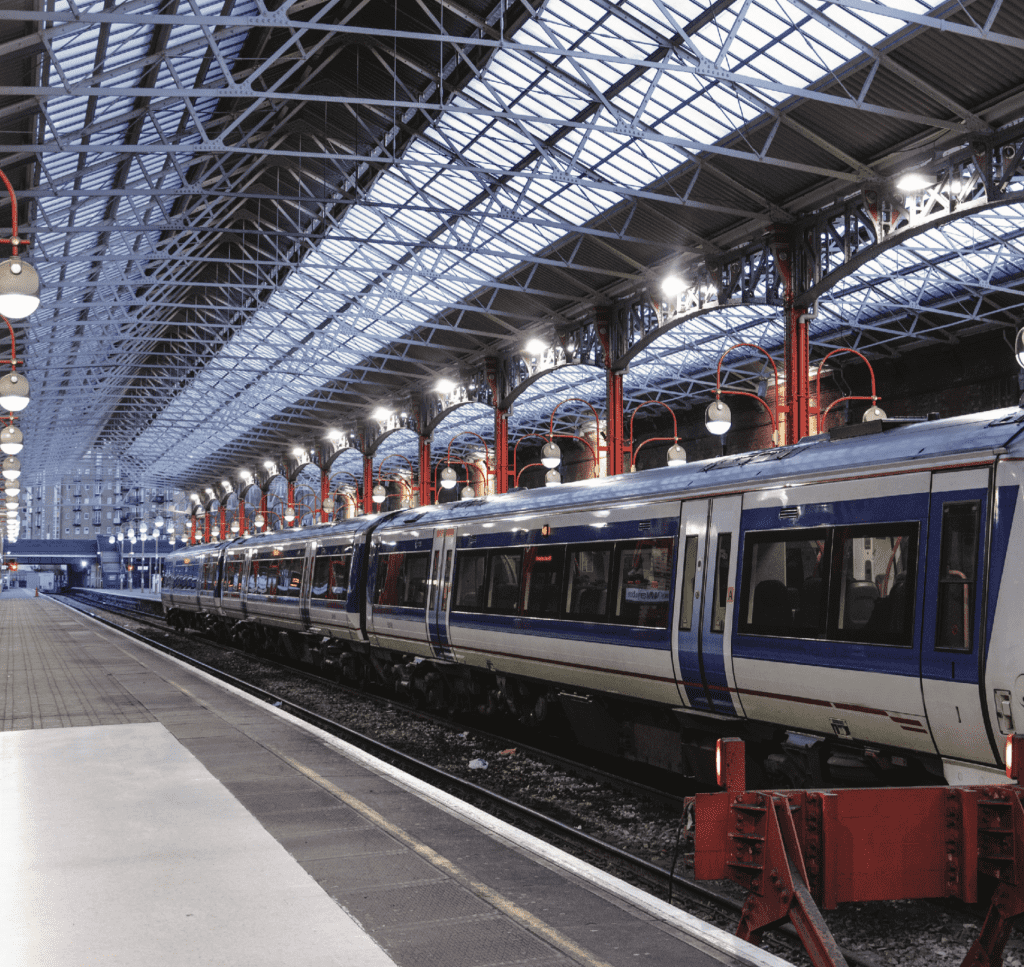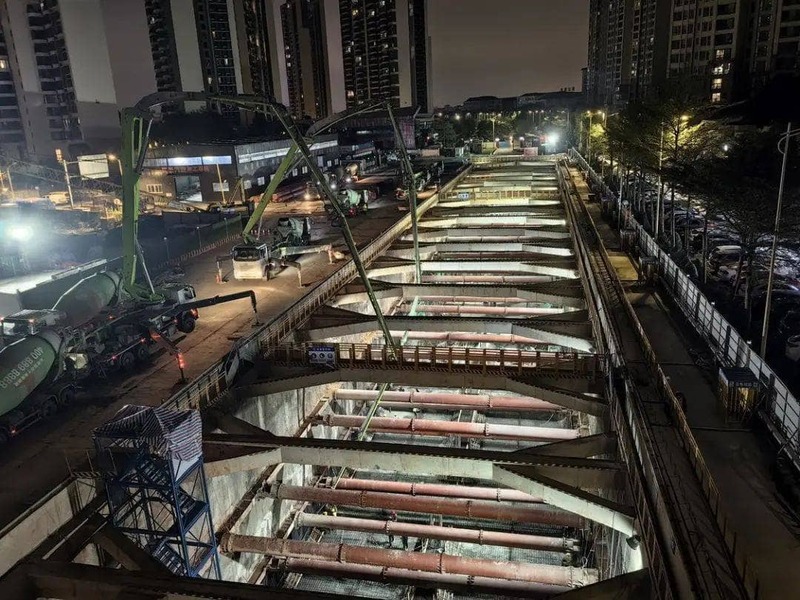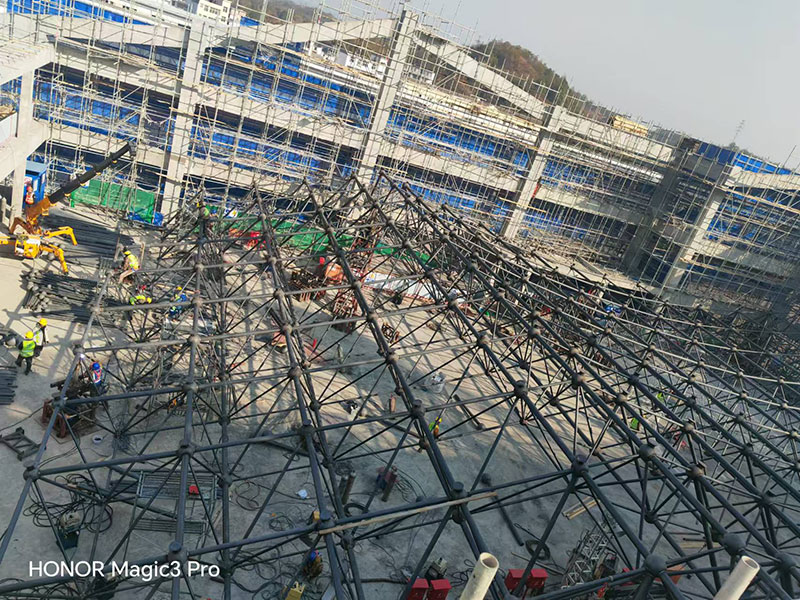1. Which rail stations are suitable for steel structure construction?
1.1 Truss structure (main building of high-speed rail station and hub station)
- Spatial breakthrough: The box-section space truss is used, and the single span can reach 120 meters without columns in the waiting hall, which is equivalent to 16 standard basketball courts running horizontally, eliminating the traditional columns blocking the passenger flow, and improving the space utilization rate by 20%-25%. The triangular unit structure allows the rods to bear only axial force, and the material strength utilization rate reaches 95%.
- Construction efficiency: The rate of prefabricated modular components in the factory reaches 90%, and the on-site assembly period is shortened by 50% compared with the traditional mode. The main structure of the 50,000 m2 station building can be completed in only 90 days, meeting the needs of the early opening of the high-speed commuter line.
- Functional integration: The load-bearing capacity reaches 6kN/㎡, and it can hang large LED display screens and intelligent guidance systems; the maintenance channel interface above the track is reserved to support equipment maintenance without stopping operation.
- Innovation in shape: Special-shaped trusses realize complex shapes such as curved surfaces and hyperbolic paraboloids through parametric design. For example, the “Kunpeng Spreading Wings” shaped roof of a high-speed rail station forms a streamlined cantilever structure by adjusting the angle of the rods, covering an area of 30,000 square meters.
- Cost reference: The unit cost is about $400-500 USD/㎡. The comprehensive cost of large-span scenarios is 20% lower than that of the concrete solution.
1.2 Special-shaped space truss structure (intercity station, transportation complex)
- Terrain adaptation: For complex landforms such as mountains and river valleys, an irregular column grid layout can be achieved through three-dimensional space trusses. For example, a station in a mountainous area uses a tree-like bifurcated truss with a single column support span of 45 meters to meet the needs of suspended station construction between canyons.
- Intelligent integration: Integrate BIM+GIS technology to achieve seamless connection between the station building and the surrounding terrain; configure an intelligent skylight system to automatically adjust lighting according to the sunlight angle, reducing energy consumption by 18%.
- Earthquake-resistant reinforcement: Buckling-resistance braces (BRBs) and viscous dampers are used, with an earthquake-resistant design of 8 degrees, which can withstand structural deformation under rare earthquakes.
- Cost reference: unit cost is $550-700 USD/㎡, suitable for hub projects with complex shapes and special geological conditions.
2. Why are steel structures the preferred construction method for global transportation hubs?
2.1 Rapid construction to seize the first opportunity of opening to traffic
- Factory prefabrication + on-site assembly mode: The main structure of the 30,000 m2 station building was completed in 60 days, 180 days shorter than the concrete solution, ensuring that the high-speed rail line is opened on time.
- Modular expansion: Reserved interfaces support “expansion during operation”. For example, a hub adds a 20,000 square meter waiting hall during operation, and passenger flow is not affected during construction.
2.2 Large-span column-free space to optimize passenger flow experience
- The column-free waiting hall, which is over 100 meters long, can accommodate 5,000 people waiting for the bus at the same time. It has clear and unobstructed views and, combined with the intelligent guidance system, improves passenger flow efficiency by 30%.
- Flexible partition system: Prefabricated aluminum alloy partition walls can complete booth adjustments within 30 minutes to adapt to functional conversions such as temporary security inspection channels and emergency isolation areas.
2.3 Green and sustainable, in line with the goal of carbon neutrality
- Photovoltaic integrated roof (BIPV): annual power generation covers 30% of the station building’s electricity consumption, and combined with ground-source heat pumps, the comprehensive energy saving rate reaches 30%.
- Material recycling: Steel is 100% recyclable, construction waste is reduced by 90%, and carbon emissions are 60% lower than concrete.
2.4 Earthquake-resistant and safe, protecting millions of passengers
- The fire resistance limit is 2.5 hours, and it is equipped with an intelligent smoke detection system and emergency evacuation simulation, which can complete the evacuation of tens of thousands of passengers within 5 minutes.
- Cooperate with IoT monitoring: real-time monitoring of structural stress, temperature, humidity, and crowd density, with an early warning response time of less than 10 seconds.
3. Application scenarios of steel structure rail stations
| Scene Type | Technical Solution | Core Performance | Cost reference |
| High-speed rail station | 120m long span truss + glass curtain wall | The annual passenger flow exceeds 50 million, and the waiting hall has a net height of 18 meters. | $600-800 USD/㎡ |
| Intercity Rail Station | Special-shaped space truss + intelligent skylight | Single span 45 meters, suitable for building stations under elevated lines | $500-650 USD/㎡ |
| Transportation complex (including bus station) | Steel frame + commercial podium integration | Vertical space utilization increased by 200%, integrating retail and catering functions. | $450-600 USD/㎡ |
| Temporary high-speed rail station (emergency project) | Modular light steel structure + quick assembly and disassembly | Completed the construction of a 2,000 square meter station building in 72 hours, supporting short-term operation for 6 months | Single module $80,000 |
4. Steel structure VS traditional concrete: In-depth comparison of traffic scenes
| Core indicators | Steel structure scheme | Traditional concrete solution |
| Maximum single span | 120 meters of column-free space | ≤35 meters (need dense columns) |
| 30,000㎡Construction period | 60 days to complete the main construction | 240 days (including maintenance) |
| Flexibility in passenger flow management | Modular partition walls for quick adjustment | Wall reconstruction requires demolition, cycle ≥ 15 days. |
| Carbon emissions | 1.5tCO₂/㎡ (61% reduction) | 3.8tCO₂/㎡ |
| Renovation cost | Adjustment of local components reduces costs by 65% | Structural demolition generates a large amount of construction waste. |
| Earthquake resistance | 8 degrees (0.3g) | 6-7 degrees, high-intensity areas need reinforcement |
5. Key Components and Technical Standards on Train station
Load-bearing system
- Steel columns: adopt GB, EN, and AISC design specifications, use Q355B S355JR A572 SM490A high-strength steel, high-strength steel with a compressive strength of 460MPa, and the column spacing can reach 15 meters, reducing the number of columns in the waiting hall.
- Space truss: inverted triangle cross section, maximum span 120 meters, optimized wind load resistance 1.2kN/㎡ through wind tunnel test, can withstand Category 12 typhoon in coastal areas.
- Foundation system: pile raft foundation + seismic isolation bearings are used to adapt to soft soil foundations, and the settlement difference is controlled within 3mm.
Roof and enclosure systems
- Create energy-saving roof: double-layer corrugated steel plate + 100mm rock wool insulation layer, heat transfer coefficient ≤0.35W/(㎡・K); photovoltaic glass transmittance 60%, annual power generation exceeds 500,000 kWh.
- Fast-track partition wall: prefabricated insulating glass + aluminum alloy frame, with a sound insulation of 40dB, which can support the opening of a fully transparent channel within 5 minutes in an emergency.
6. Frequently Asked Questions
Q1. How is the seismic performance of steel structure rail stations?
A: Steel structure rail stations prioritize seismic safety with high-strength steel frames and anti-buckling braces, acting like seismic “armor.” They can withstand 8-degree (0.3g) earthquakes, with flexible joints that deform without collapsing. In one case, a station endured a 7-degree quake without structural damage. Engineers run repeated simulations to keep shaking within safe limits (displacement angle <1/500). Compared to concrete structures, which handle only 6–7 degrees, steel stations offer far greater safety in earthquake-prone areas.
| Compare Projects | Steel structure rail station | Traditional concrete structure railway station |
| Main material | Q355B S355JR A572 SM490A High-strength steel frame with buckling-resistance braces (BRB) | Reinforced concrete |
| Earthquake resistance level | 8 degrees (0.3g) | 6-7 degrees |
| Key technologies | Flexible node design allows limited deformation; SAP2000 software time history analysis ensures displacement angle <1/500 | Conventional rigid node design |
| Actual earthquake resistance performance | The main structure of a high-speed rail station remained intact in a magnitude 7 earthquake. | No relevant earthquake-resistant cases in high-intensity areas are mentioned. |
| Safety in high-intensity areas | Significant improvement | Less secure |
Q2. How much faster is the construction cycle of a steel structure rail station than the traditional method?
A: A Steel structure can make the construction speed more than twice as fast! Take the 30,000 square meters of the rail station building as an example. It only takes 60 days to build the main body with a steel structure. If it is replaced with a concrete structure, it will take 240 days, including the maintenance time. This is mainly because the components of the steel structure can be made in advance in the factory (the error does not exceed 2 mm), and they can be transported to the site for direct assembly.
Work will not be delayed on rainy days, and there is no need to make it wet everywhere like traditional construction. For example, there is an intercity station that uses the “truss overall lifting technology” to hoist an 800-ton truss, which takes only 4 hours. If it is assembled piece by piece according to the old method, it will take at least 20 more days.
Q3. How is the sound insulation effect of the steel structure rail station?
A: To make the waiting environment quieter, the steel structure rail station has made great efforts in sound insulation. The wall adopts a double-layer design, with light steel keels as the frame, plus 12 mm thick gypsum board and 50 mm thick rock wool, just like wearing two layers of “soundproof clothing” on the wall, which can block most of the sound, and the sound insulation effect is better than the 24 cm thick traditional brick wall. The roof is made of three layers of materials, namely color steel sandwich panels, sound insulation felt, and sound-absorbing cotton, which can reduce the noise from the train tracks by more than 25 decibels.
The floor slabs are also not dropped. After laying elastic shock-absorbing pads, even if someone walks on them, there will not be much noise below, and the noise is controlled within 65 decibels. In this way, the waiting hall is much quieter, which can fully meet the high-standard requirements of the high-speed rail station for a quiet environment.
| Compare Projects | Traditional construction method | Steel structure rail station construction method |
| Wall sound insulation | 24 cm-thick traditional brick walls with limited sound insulation | Double-layer design, light steel keel frame with 12 mm thick gypsum board and 50 mm thick rock wool, the sound insulation effect is better than traditional brick wall. |
| Roof sound insulation | No special emphasis on multi-layer sound insulation design | The three-layer stacking of color steel sandwich panels, sound insulation felt, and sound-absorbing cotton can reduce the noise of train tracks by more than 25 decibels. |
| Floor sound insulation | No targeted sound insulation treatment | Lay elastic shock-absorbing pads to control floor noise within 65 decibels. |
| Overall Effect | The waiting environment is noisy. | Meet the high standards of high-speed rail stations for a quiet environment. |
Q4. Can steel structure rail stations adapt to complex terrain?
A: Steel structures offer great flexibility, especially for stations in challenging terrains. In mountainous areas, special-shaped space trusses act like modular building blocks, with adjustable column heights to match slopes. For example, a scenic station used “stepped truss” technology to handle a 15-meter drop, seamlessly fitting the terrain. On soft soil, pile foundations connect flexibly with steel, keeping settlement differences within 5 mm—thinner than a coin.
Q5. Is the later maintenance cost of the steel structure rail station high?
A: The full life cycle maintenance of the steel structure is very economical: its average annual maintenance cost accounts for only 5% to 8% of the initial construction cost. The main expenditure is concentrated on the anti-corrosion treatment of the steel surface and structural safety testing. The recoating cycle of anti-corrosion paint is about 10 years, and the cost per square meter is controlled at $15-20 USD; if the hot-dip galvanizing process is used, the maintenance cycle can be extended to 15 years. Combined with the deployment of the intelligent monitoring system, 24-hour structural health monitoring is achieved through stress sensors.
Once an abnormality occurs, an immediate warning is issued to effectively avoid the high repair costs caused by sudden structural damage. In contrast, concrete buildings need to frequently deal with problems such as crack repair and surface renovation, and the annual maintenance cost accounts for 8%-12%. It has been calculated that the full-cycle operation and maintenance cost of steel structures from completion to retirement can be reduced by 15%-20%.
| Compare Projects | Steel Structure | Traditional concrete building |
| Annual maintenance cost as a percentage of construction cost | 5% – 8% | 8% – 12% |
| Main maintenance items | Repaint every 10 years (15 years for hot-dip galvanized steel) with anti-corrosion paint ($15 – 20 USD per square meter), and conduct regular structural safety inspections. | Crack repair, wall refresh |
| Intelligent monitoring | Equipped with stress sensors for real-time monitoring and early warning of faults | None |
| Life cycle cost | Save 15% – 20% | No significant cost advantage |
XTD Steel Structure has injected large-span technology, intelligent construction, and green concepts into rail station construction, and has successfully delivered more than 10 steel structure transportation hub projects. From the magnificent dome of the high-speed rail station to the smart shape of the mountain station, we make each station a smart gateway to the city through the full chain service of “BIM forward design-intelligent manufacturing-precise installation”. Choosing a steel structure is not only choosing a faster construction speed, but also choosing a future-oriented transportation space solution.




